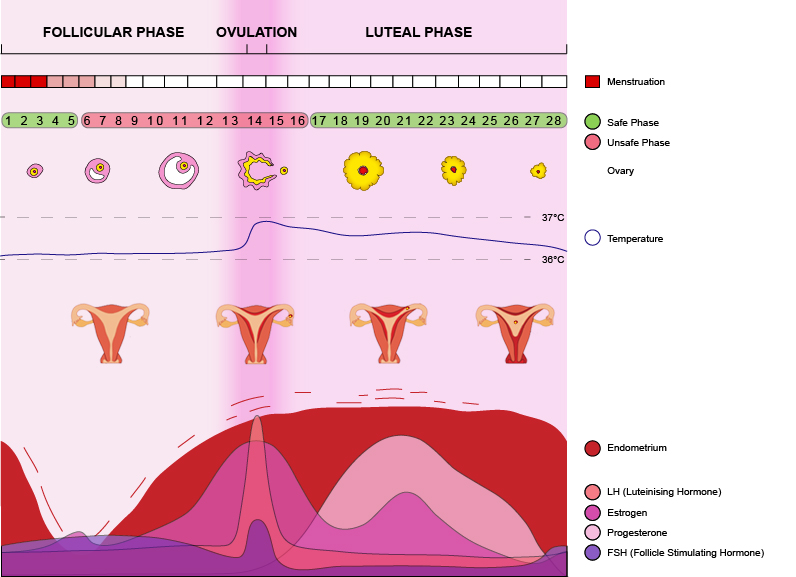The average female cycle (menstrual cycle or ovarian cycle) lasts 28 days but length variation between 23 and 35 days is considered as normal. According to definition the first day of the period is the first day of the cycle [MENSTRUATION], since it's the clearest sign. [1]
Phases
A cycle starts with the menstruation on day 0 which can last for 7 days. During this phase a new egg (or two) starts to mature in the ovaries [OVARIES]. Around day 14 a mature egg is released from the ovarian follicles into the oviduct [FALLOPIAN TUBES] travelling towards the uterus [UTERUS]. During the first 24 hours after ovulation the egg can be fertilized by sperm. Until the following menstruation body temperature rises 0.5 degrees. [1] [2]
The developing embryo takes about three days to reach the uterus and another three days to implant into the endometrium. After nidation, pregnancy can start. [1] [2] [CONCEPTION]
If no fertilization takes place, macrophages (cells of the immune system) destroy the egg. [4] In this case, menstruation starts again around 14 days after ovulation, that is, the endometrial lining is shed and a new cycle begins. [1] [2]
Hormones
The female cycle is steered by various hormones, such as GnRH (Gonadotropin- releasing hormone), FSH (Follicle-stimulating hormone), LH (Luteinizing hormone), estrogens and progesterone. The main control center of the cycle lies in the brain which by turns acts on the female gonads and the egg. [3] [4]
The hypothalamus is an endocrine gland which releases GnRH and thus stimulates the release of FSH and LH from the epiphysis. During the first half of the cycle the egg grows under the influence of FSH and releases estradiol, an estrogen. As soon as it has reached a certain concentration, LH is releases from the epiphysis. The LH causes ovulation, the egg leaves the ovary with the follicle. At this point, the follicle is a protective cover for the egg, and develops into the yellow body (of the ovary) which forms estrogen and progesterone. They are responsible for a good perfusion and maturation of the endometrial tissue. In case of no nidation, the yellow body aborts, the progesterone level decreases and the menstrual cycle begins. [3] [4] [5]
Further Links:
Menstruation, Sexplantation, Dr. Lindsey Doe, 2014 (YouTube)
© Kerstin Rajnar, 2016


